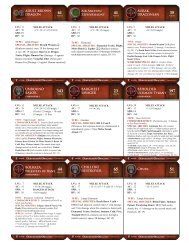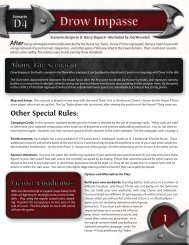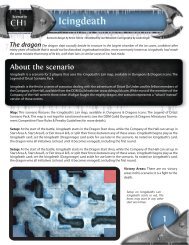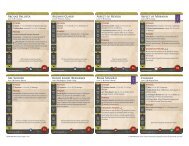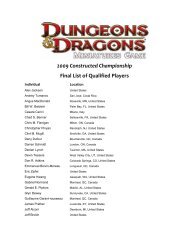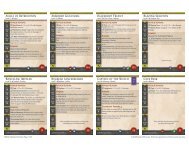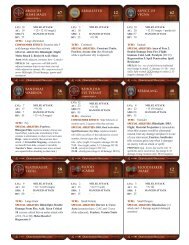Create successful ePaper yourself
Turn your PDF publications into a flip-book with our unique Google optimized e-Paper software.
MORALE<br />
Damage, and the effects of some special abilities and spells, can force creatures to lose heart<br />
and run away. This is called routing.<br />
MORALE SAVE<br />
To determine if a creature routs, make a morale save. As with any save, roll the d20 and add<br />
the creature’s Level (Save) number, then compare the result to the DC. Unlike other kinds<br />
of saves, a morale save adds the commander’s Commander rating if the creature is under<br />
command; see below. If the save result equals or exceeds the DC, the save succeeds. The DC<br />
for all morale saves is 20.<br />
As with any save, a natural 1 on a morale save always fails and a natural 20 always succeeds.<br />
A creature can’t voluntarily fail a morale save or choose not to make one.<br />
Reduced to Half Hit Points<br />
When a creature’s hit points drop to half its starting total, it must make a morale save to avoid<br />
routing. If a creature has already made a morale save (successful or not) for being reduced to<br />
half its hit points, it doesn’t have to make another one.<br />
Command and Morale Saves<br />
Any creature that is under command adds the commander’s Commander rating to its morale<br />
save as a bonus.<br />
Multiple Commanders: If a creature making a morale save is under the command of two or<br />
more commanders, use the highest Commander rating.<br />
Commanders: A commander can always add its Commander rating to its own morale<br />
saves, even when it’s routing, stunned, or otherwise unable to command other creatures. If a<br />
commander is under command by another commander, it uses its own Commander rating or<br />
the other commander’s, whichever is higher.<br />
Routing<br />
A creature that fails its morale save routs (runs away) and attempts to flee the battle map. It<br />
immediately moves at double speed by the quickest path toward the squares marked as the<br />
exit for its warband (Exit A or Exit B). Upon reaching its exit, a routing creature moves off the<br />
battle map if it has any remaining movement.<br />
Quickest Path: Move the routing creature along the most efficient, quickest path toward its<br />
exit. If the opponent shows you a faster path to that exit, the routing creature must take it.<br />
(This might mean that it moves past adjacent enemies, which can make attacks of opportunity<br />
against it.) If some circumstance blocks all paths to the exit, a routing creature moves to get as<br />
close as possible to an exit square.<br />
Routing Off the Battle Map: If the routing creature’s movement takes it off the battle map, it<br />
is eliminated and out of play. A creature that occupies more than 1 square exits when any of<br />
its squares move off the battle map.<br />
What Routing Creatures Can Do<br />
Routing creatures just run away. They can’t attack, cast spells, threaten adjacent squares, make<br />
attacks of opportunity, grant a bonus for flanking, use special abilities that have to be activated<br />
or targeted, or put creatures under command. They don’t make morale saves except to rally.<br />
21



